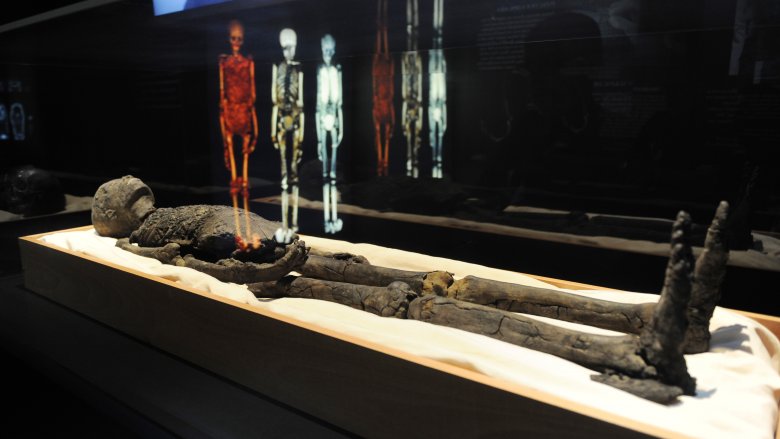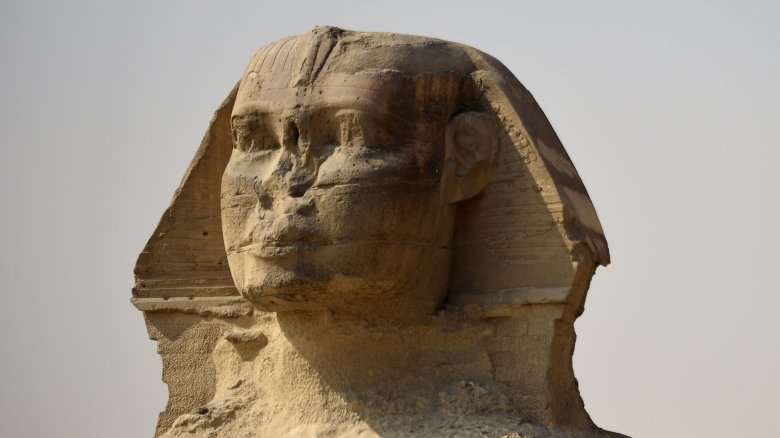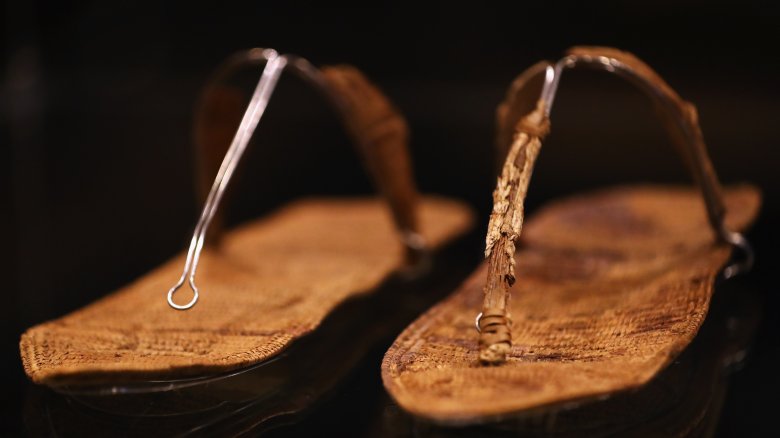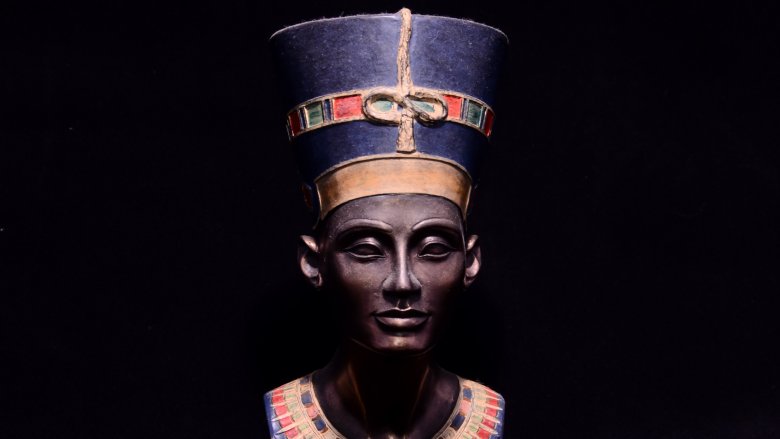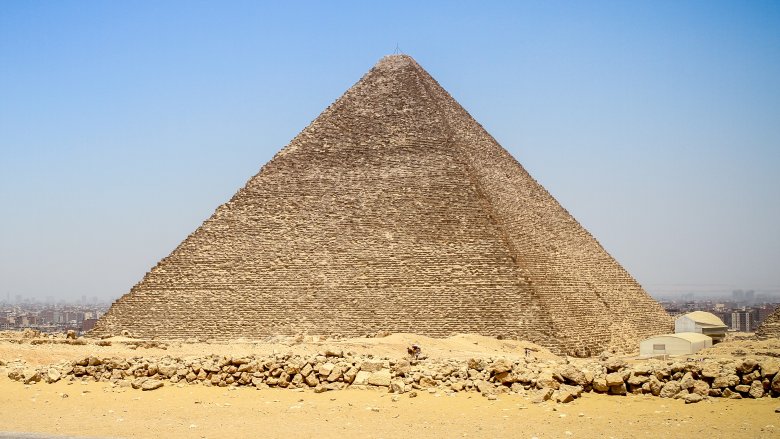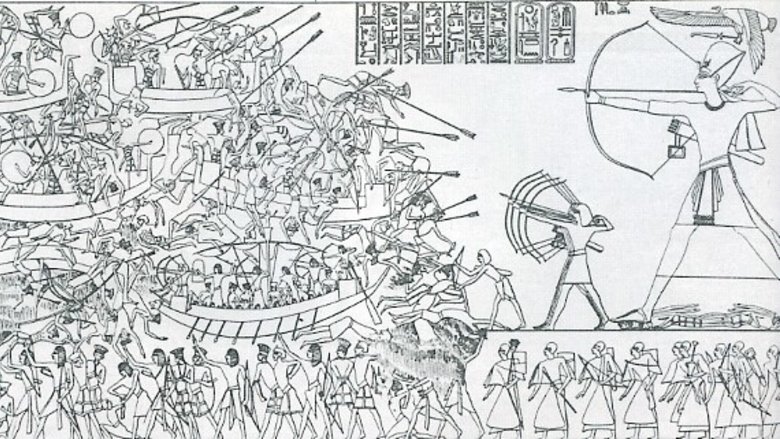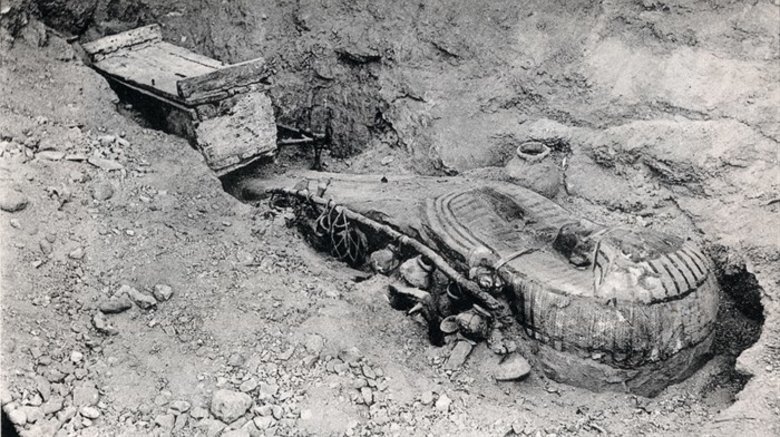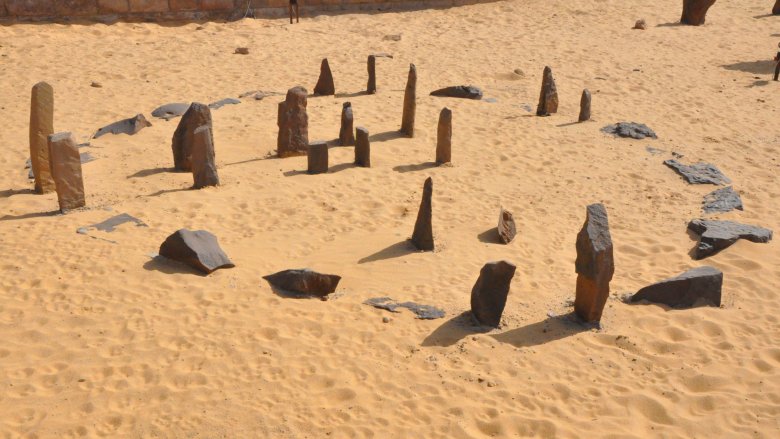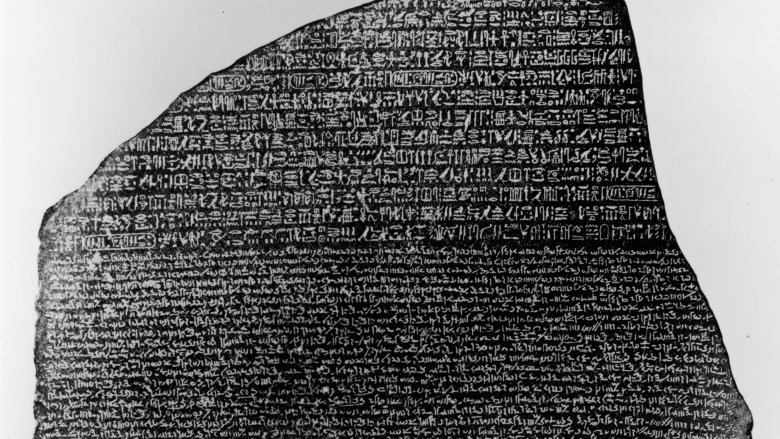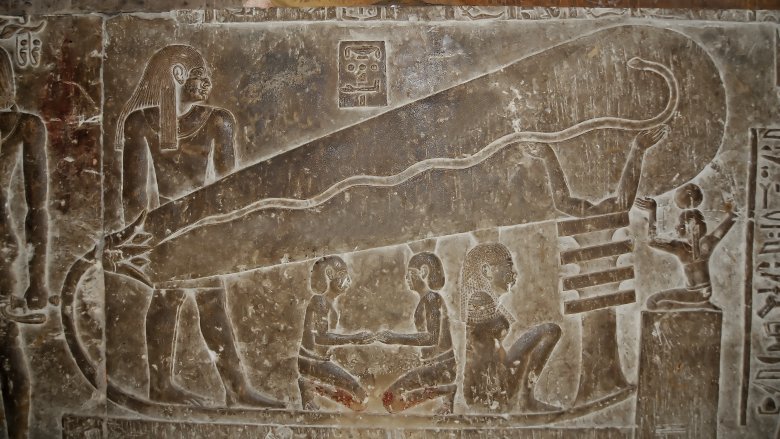Things About Ancient Egypt That Still Can't Be Explained
Few civilizations have a more mysterious reputation than ancient Egypt. But the point of a mystery is to solve it, and over the years we've researched and studied our way to learning a lot about the land of hieroglyphs and holy cats. But there's still a lot left to learn. Perhaps one day we'll uncover the answers behind the following questions, but for now all we can do is guess. Here are things about ancient Egypt that still can't be explained.
How did King Tut die?
King Tutankhamun (Tut if you can't spell) is perhaps the most famous of all Egyptian pharaohs, despite dying young. But how did he die? Sadly, any obituary in the Ankh Times has long since been lost to the ages. So all we've got is a few decent guesses.
In 2013, a group of UK researchers released a documentary called Tutankhamun: The Mystery of the Burnt Mummy. Based on X-rays taken of Tut in 1968 (along with a CT scan done in 2005 by Egypt's Supreme Council of Antiquities), the documentary reveals he had significant damage to his ribs, along with a broken leg. That led the team to conclude that Tut likely died from a chariot crashing into the poor boy-king.
But National Geographic pointed out other possibilities. It could've been a kick from a chariot horse that did him in, or possibly even a hippo attack (unluckily for him, hippos were not extinct in Egypt back then). Then there's his ribs — many are missing. They could've been shattered in an accident, but they also might have been sawed away by World War II-era thieves trying to get to valuable beads stuck on his chest.
Then you've got another theory, put forth by Professor Albert Zink, head of Italy's Institute for Mummies and Icemen (as reported by the Jerusalem Post). To Zink, who relied on 2,000 computer scans plus DNA testing of Tut's family, Tut's chariot accident was near-impossible. One big reason? He had a clubbed foot and couldn't stand on his own — inside his tomb are 130 walking canes, which he probably didn't use for fashion's sake.
Zink thinks Tut likely died because he was the product of incest — his parents were brother and sister — and so his already-weak body simply gave out on him. To further complicate matters, Tut suffered from malaria. That theoretically could've killed him, but even Zink admits they have no way of knowing for sure. For now, the only thing ironclad about King Tut's death is that it happened.
Where is Alexander the Great's tomb?
Few people came closer to ruling the entire known world than Alexander the Great.Yet, for such a famous guy, we have no idea where he's actually buried.
Archaeology Magazine published two articles by Robert Bianchi in 1993 and 1995 about the search for Alexander's tomb. As it turns out, there was never supposed to be a tomb at all — Alexander wanted to be thrown into the Euphrates River upon his death in 323 BC, so it would disappear and his followers would think he rose to Heaven to be with his father, the god Ammon. His generals, however, chose to bury him instead, and he supposedly wound up entombed in three different places. First, he was buried in Memphis, Egypt. Then, during either the 4th or 3rd century BC, he was moved to a new tomb, in Alexandria. Later on still, he got a new tomb, also in Alexandria. In AD 215, Roman Emperor Caracalla visited the tomb, and that's the last recorded thing we know about it. At some point, the tomb was likely damaged and vandalized, and now we don't have any part of it to look at, including Alexander's body. Maybe Ammon took him away after all.
As of 1993, the Supreme Council for Antiquities recognized 140 separate searches for Alexander's tomb and body, and each has had the exact same amount of luck: none. Over twenty years later, we still know just as much. The only thing everybody agrees on is that he was indeed buried in Alexandria and stayed there until his tomb disappeared. Which makes sense — if the city's named after you, why would you want to leave?
What was the Sphinx's original name?
For centuries, we knew next-to-nothing about the Sphinx. Until 1817, all we could see was its head peeking out from layers and layers of sand. But since then, thanks in large part to the efforts of archaeologist Mark Lehner (as recapped by Smithsonian.com), we've learned a lot about the Sphinx. We have a real good idea who built it (Pharaoh Khafre), how he got it done (hundreds of paid laborers using a humongous chunk of nearby limestone), and how long it probably took (based on the copper and stone tools they were using, probably around three years if 100 people worked on it). Other than that, though, we've got ourselves guesses — and that's about it.
For one thing, we still have no idea what the ancient Egyptians even called the thing. "Sphinx" is a Greek term that didn't exist when Khafre built his monument — what he and his people called it is currently a total mystery. The biggest issue is that, as Egyptologist James Allen put it, "The Egyptians didn't write history ... so we have no solid evidence for what its builders thought the Sphinx was." For all we know, they called it Bob.
Another thing about Bob that still confuses us is just what it symbolizes. Obviously it was built for a reason — but what reason, we don't know. Apparently, a god from that era, Ruti, was comprised of two lions conjoined at the back (like Cat-Dog, basically), guarding the entrance to the underworld. That sounds an awful lot like the Sphinx, but without a second lion nearby to confirm, all we have is a hard "probably."
What are the hidden temple shoes all about?
In 2004, archaeologist Angelo Sesana published a report in the journal Memnonia, regarding a 2,000-year-old find he and his team had stumbled across in Egypt. As recapped by LiveScience, Sesana's team found a jar "deliberately placed in a small space between two mudbrick walls" inside a Luxor temple. Inside were seven pairs of shoes. As for why the shoes were left in that jar, and the fate of their owners, we simply don't know.
Ancient Egyptian footware expert André Veldmeijer, whose job is officially more interesting than yours, examined pictures of the shoes sent to him by Sesana. His assessment was that these shoes were likely quite expensive and foreign-made, so whoever put them there were likely high-society. But how high, we don't know. They could've been royalty, or simply well-to-do commoners. Either way, they apparently felt the need to discard their expensive footwear in a jar, place the jar between two walls in a tight place others weren't likely to look, and then just leave them there. Were they possibly going to retrieve them later, only to be murdered first? Did they leave them there for others to use, like an ancient Goodwill? Nobody knows.
We also don't know exactly how old they are. They're at least 2,000 years old, but without carbon dating, there's no way to know for sure. Sadly, carbon dating might prove challenging, as the shoes didn't handle well at all when removed from their hidey-hole. As Veldmeijer recapped in the Journal of the American Research Center in Egypt, the shoes looked to be in shockingly pristine shape when left alone. But almost as soon as they were handled, they crumbled and became extremely brittle. They're currently protected by the Ministry of State for Antiquities, so anyone interested in unlocking this mystery might want to get on it stat, before the shoes crumble into dust forever.
What's with the pained expression mummy?
Mummies with mouths agape, looking like they're screaming, aren't really a new thing. They're not even really "screaming" — many mummies had their mouths forced open during special ceremonies meant to make it easier for spirits to eat, drink, and breathe in the afterlife. However, there's one mummy in particular that looks like it actually was screaming. In fact, it looks like it's in downright agony, and no one knows why for sure.
According to National Geographic, "Unknown Man E" was discovered in 1886, and immediately stood out because it looked like he was screaming in pain. Many theories abound about how he died, but nothing's been confirmed except that it probably wasn't pretty. Some researchers think he might have been poisoned, or possibly buried alive. Others think he was a murdered Hittite prince, though archaeologist Bob Brier out of the University of Long Island disputes that, saying, "They're not going to mummify this guy if they murdered him ... they're going to get rid of the body." That makes sense — gotta hide the evidence, after all.
A 2008 analysis of Unknown Man E suggests he might be Prince Pentewere, executed for planning to murder his father, Pharaoh Ramses III. If true, it would explain how he was buried: wrapped in a skeepskin, which meant he had done bad things in his life, according to Zahi Hawass, Secretary-General of Egypt's Supreme Council of Antiquities. It might also explain why he had no grave marking — that way, he wouldn't be able to join the afterlife, the worst possible punishment for an ancient Egyptian. It might even explain why his mummification was so unimpressive: he wasn't dehydrated, his brain was still in his skull, and they poured resin down his throat rather than into his cranium. But this entire theory of who he might've been is just that: a theory. Without DNA testing, all we're left with is a cool story that, for some reason, Hollywood still hasn't turned into a movie.
What happened to Queen Nefertiti?
Aside from Cleopatra, there might not be any more famous an Egyptian queen than Nefertiti. For years she ruled alongside Pharaoh Akhenaten, until she just ... vanished. After 1336 BC, there are no records of what happened to her. We don't even have her tomb or mummy, and we know how thorough the Egyptians were regarding dead people. But we don't know for sure — all we have are theories.
One such theory, as written by History.com, is that she became a co-regent with Akhenaten and changed her name to Neferneferuaten. Another idea is that she changed her name to Smenkhkare and became a full-blown pharaoh while disguised as a man. But these theories currently have nothing to back them up aside from these being names that come next in the royal timeline, and Nefertiti's being absolutely nowhere.
We may eventually learn something more about Nefertiti, however. In 2015, Egypt's minister of antiquities (as reported by The Guardian) announced that an additional chamber (or possibly two) may have been found in King Tut's tomb, and one of them may wind up being Nefertiti's crypt. If so, researchers could perhaps finally deduce when she died, and if any artwork in the crypt indicates whether she took power in her own right, was brutally murdered somehow, or simply vanished to a life of post-royalty anonymity.
How many chambers are in the Great Pyramid?
Everyone knows and loves the Great Pyramid of Giza — it's the only Natural Wonder still standing, so it deserves our respect. For awhile, it seemed like we knew exactly what was inside, too. You had three chambers: the King's Chamber, the Queen's Chamber, and the Grand Gallery. But very recently, more chambers have been discovered, prompting the question, "how deep does this rabbit sarcophagus go?"
In October 2016, researchers with Scan Pyramids, a group that uses methods such as muography (x-rays, basically) and thermography, uncovered evidence of two possible new chambers within the pyramid — one behind the pyramid's North Face, and one more behind it's descending corridor. This seems to confirm what robots had been noticing for awhile — that there's more to the pyramid than just those three rooms. Yes, that's right: robots.
Since 1993, several small robots have entered the Pyramid to learn what's in there, and they've come back with mysterious images of tunnels no one had seen since they built the thing 4500 years back. Though these tunnels are likely too small to be of any use, it did suggest that there may be more hidden areas in the Pyramid than we thought. And thanks to Scan Pyramids, that thought may prove to be correct.
And if there are two more rooms, how many others are there? Are these rooms divided into sub-rooms? Until we do more testing, possibly with more robots, we truly don't know. And honestly, that's a good thing. The Great Pyramid is a Wonder, after all, so it should make us wonder as long as possible.
Who were the Sea Peoples?
Every hero needs rivals, and for awhile it seems like the Joker to Egypt's Batman were the "Sea Peoples." And much like Joker, we don't know very much about who they were. In fact, we know basically nothing.
In broadest strokes, as told by the Ancient History Encyclopedia, the Sea Peoples were a group of pirates and raiders who roamed the Mediterranean looking for places to loot. A major target of theirs was Egypt, who apparently decided to deny them history by barely mentioning them at all. Outside of the occasional blurb like in the Stele at Tanis ("They came from the sea in their war ships and none could stand against them,") scrolls and documents of the time say precious little about the invaders from the sea.
Rulers like Ramses II mentioned them in writing, but didn't bother to say who they were or where they came from. Most likely this is because any ancient Egyptian reading these inscriptions already knew who they were. He did say they were allied with the Hittites, but they were also mercenaries for Ramses himself, apparently. If that's true, we may not know who they were, but we can certainly say they weren't all that united.
But don't think they were from where the Hittites called home (modern-day Turkey), because the pharaoh Merenptah wrote that they had allied with the Libyans. Most likely, they were a group of mercenaries who came from all over and banded together to conquer various lands, Egypt in particular. But without writings that say as much, that guess is as good as anyone else's.
Where exactly was the Kingdom of Yam?
Somewhere in Egypt, over 4,000 years ago, existed a mysterious kingdom called Yam. It was a profitable land-of-plenty. As recapped in the book Black Genesis: The Prehistoric Origins of Ancient Egypt by Robert Bauval and Thomas Brophy, the Egyptian treasurer Harkhuf mentioned (in writings on his tomb) that he returned from a Yam expedition with some cool stuff. Stuff like, "three hundred donkeys burdened with incense, ebony, hekenu perfume, grain, leopard skins, elephant tusks, many boomerangs, and all kinds of beautiful and good presents."
It was a sweet place, is what he was trying to say.
Sadly for such a pristine place, Yam has long been lost, and Egyptologists don't even know where the kingdom was. According to Black Genesis, most Egyptologists believe Yam existed somewhere accessible to Egyptians, like south or westward along the Nile Valley — the desert up north was simply too harsh, dehydrated, and unforgiving. But there's one big issue with that hypothesis: Harkhuf's writings. In the same inscription quoted above, he bragged about making the trip to Yam and back in seven months. No way would it take seven months to trek somewhere "safe." Bauval and Brophy calculated that, based on the speed of the donkeys he used to ride to Yam and back, Harkhuf rode at least 900 miles one way. That's way into that "dangerous desert" territory many Egyptologists still insist he — and by extension Yam — would perish in.
No matter which theory you subscribe to, both have one thing in common: they shrug their shoulders at the exact location of this paradisiacal land of incense and leopard skins.
Who was buried at Qurna?
In 1908, British Egyptologist Flinders Petrie stumbled across a royal burial site no one had ever seen before. Apparently, he had also stumbled across royalty no one had ever heard of before, because over a century later, we still don't know who was buried there.
As explained by National Museum of Scotland (which currently stores the coffins), Petrie's team was digging around Qurna, Thebes, when they unearthed the ornate graves of two people. The coffins were dated to around the XVII or XVIII dynasties, making the bodies at least 250 years older than King Tut. We know that one mummy was a young woman and another was a child, presumably hers. They both wore priceless jewelry made of gold and ivory, so clearly they were important. Unfortunately, the inscription that might reveal who they are has been damaged beyond legibility — it almost certainly reads "King's great wife," but the part where the king might namecheck her and their kid isn't there anymore.
There are a few possibilities, based on the queens of the time. To name a few, she might have been Ha'ankhes, Nubemhat, or the as-yet unidentified wife of Rahoptep or Inyotef V. We have far fewer, if any, clues about the kid's identity — for the time being, it's looking to stay that way. The pair are scheduled to be unveiled at the Scotland Museum in 2018, once a new Egyptian gallery is all set to go. Maybe then someone will figure out who they are and the museum's guests will finally learn the the truth behind these mysterious figures.
Or they can just gawk at the pretty jewelry. Either way.
Who built the Nabta Playa Stone Circle?
Stonehenge isn't the only circle of mysterious rocks out there — Southern Egypt's got one, too. The Nabta Playa Stone Circle is a collection of flat rocks with taller rocks in the middle, discovered in 1974 by a team of scientists. (A reconstruction is pictured above.) According to Archaeology Expert, it's much smaller than Stonehenge but may have served the same purpose. We say "may have" because nobody can conclude for certain why the Stone Circle existed in the first place.
Some people, such as astrophysicist Dr. Thomas Brophy in his 2005 paper Satellite Imagery Measures of the Astronomically Aligned Megaliths at Nabta Playa, theorize that, based on satellite views, the Circle was constructed for space-related reasons. Then there's the 2007 paper Astronomy of Nabta Playa, which theorizes that the placement of the stones, plus livestock and human graves nearby, "reveals a very early symbolic connection to the heavens."
The thing is, we don't know what that connection might be. Stars? The Sun? An ancient god we don't know about yet? We still don't know the true target of the Circle's rocky wrath, mostly because, as Brophy wrote, "Only a small number of the subsurface bedrock sculptures have been excavated." It's hard to reach any definite conclusion when you don't have the whole thing in front of you.
Which script on the Rosetta Stone is the main one?
Before the language-learning software, there was only one Rosetta Stone, and it was in Egypt. It's been decades since linguists deciphered the three languages on the Stone — hieroglyphs, ancient Demotic Egyptian, and ancient Greek. But we don't yet know which of the three dialects is the main one, the one that came first and inspired the other two to translate themselves and catch up.
It's hard to know for sure, since all three were widely used in ancient Egyptian times — it's not like Demotic was some weird Esperanto-esque blip on the radar that nobody really spoke. But experts differ on which was "the" script. John Ray opines, in his book The Rosetta Stone and the Rebirth of Ancient Egypt, that "the hieroglyphs were the most important of the scripts on the stone; they were there for the gods to read, and the more learned of their priesthood." Pretty straightforward, right? Hieroglyphs are certainly the most fun to draw of the three, so why not make them the most important? Not so fast, say others. According to Cracking Codes: The Rosetta Stone and Decipherment, all three were equally important. Since many Egyptians spoke both Greek and Egyptian, had names in both languages, and worshiped gods who had names in both languages, it made sense for all three dialects to be equally common. But if, as Ray claims, the gods like hieroglyphs best, who's going to argue with them?
What is the Dendera Light?
The Dendera Light, even by weird ancient Egyptian standards, makes no sense. It's a drawing of a man holding what looks to be a gigantic tube that is taller and wider than he is. And nobody knows for sure what it is, though the more fantastically minded among us certainly have some creative ideas.
Certain pseudo-scientists, such as Erich von Däniken (who pals around with Giorgio "Aliens" Tsoukalos, to clue you into his mindset) think it's a giant battery or electric tube. If you paid attention for even one day in school, you know the ancient Egyptians didn't have electricity, but that isn't stopping people from arguing that they did and that humanity just conveniently forgot about it for 3,500 years. Then you've got more traditional, rational Egyptologists, who think the "Light" might be, according to Atlas Obscura, a "combination of a Lotus flower, a Djed pillar (a symbol of stability, symbolized by the outstretched arms), and a snake rising from the flower through the womb of Nut [the sky goddess]." There are inscriptions around the drawing that suggest it's a lotus flower, out of which will emerge the rising sun, but it's impossible to say for sure. The Egyptologists are probably closer to being right then the battery people, but there's always the possibility that it's just a giant, State Fair-winning eggplant.
Where's the rest of the second sphinx?
Everyone knows the Great Sphinx, probably because we already talked about it in this article. But a new one was found recently, except we've so far been only been able to locate a small part of it. We don't know what happened to the rest of it.
As CNN reported in 2013, archaeologists in Israel discovered the legs of a 4,000-year-old Sphinx. It appears to be tied to King Mycerinus, but according to Amnon Ben-Tor, head of the excavation, it was long ago broken up and its pieces scattered. Likely, either Mycerinus or his city fell. In Egyptian tradition, once a ruler fell, so did their statues. As for where the remaining pieces of this brand spanking new sphinx are, nobody knows. Luckily, any pieces that still exist won't be too hard to carry. Based on the feet, this is a much smaller Sphinx than the famous one in Egypt. Archaeologists estimate it weighs maybe a half-ton and stands just a yard high. It's the perfect size for any child's bedroom.
There's an additional mystery, too: how the Sphinx got to Israel in the first place. Ben-Tor wonders if it was a gift from Mycerinus to the king of nearby Hazor, but he and his team won't know for sure until they've dug up the entire site. Don't hold your breath for it to happen, though — Ben-Tor estimates it'll take 600 years to dig up the entire 200-acre site. That's a lot of sand.
